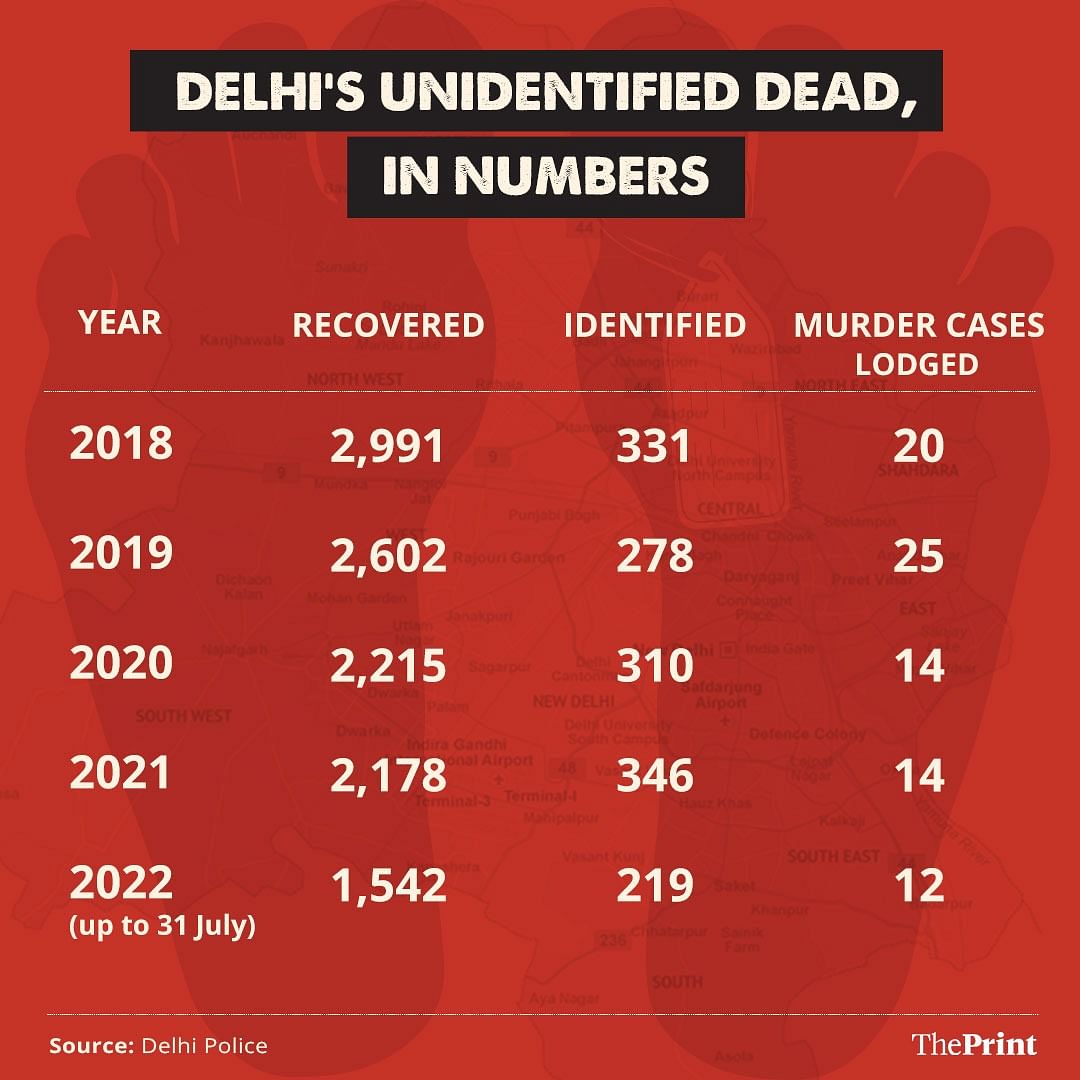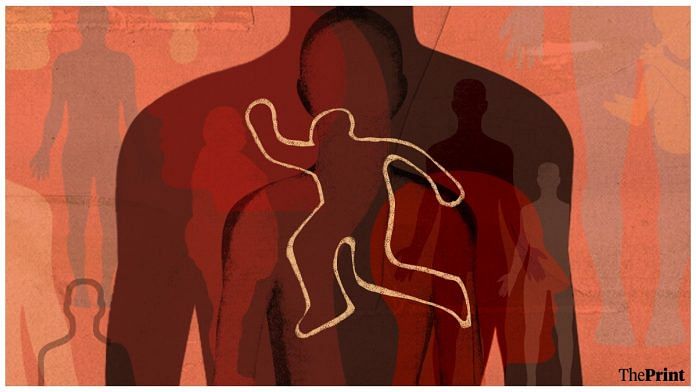New Delhi: He was around 35-40 years old when he died. His last moments were most likely gruesome. Someone beheaded and dismembered his body, and then packed the parts neatly in black polythene bags before dispersing them within a 150-200-metre radius in an open ground behind the Cyber Police Station in East Delhi.
On 7 June, his decomposing limbs were found and then, a day later, his skull. His torso hasn’t yet been discovered. The police have lodged a murder case but his identity, and that of his killer or killers, is still a mystery two months later. All that doctors could ascertain after an autopsy was that he was a male, and his approximate age.
Just over a month later, a passerby spotted a human leg peeking out from a plastic sack near the Outer Ring Road in North Delhi’s Wazirabad area. Inside the sack was the decomposing body of a man aged around 30-35. He, too, had no identification on him. A murder case has been registered, but no one knows who he is either.
Today, he is just another UIDB (unidentified dead body) listed on the Zonal Integrated Police Network (Zipnet) website, along with thousands of others, all nameless, and many faceless.
Delhi Police data for five years, accessed exclusively by ThePrint, shows that an average of 5 to 8 unidentified bodies were found daily in the national capital from 2018 to 2021. Out of the thousands found each year, only a fraction are ever identified.
Speaking to ThePrint, Suman Nalwa, Delhi Deputy Commissioner of Police (DCP), public relations, said that not all unidentified bodies are victims of crimes. Other causes of death range from suicide and accidents to old age and illness.
“Delhi sees a lot of migrants and a floating population. People from across the country, from diverse backgrounds, come to Delhi for different reasons — socioeconomic, addiction and substance abuse, crime, differences within the family etc. The reasons for deaths are often natural, like diseases, malnutrition etc,” she said.
The Zipnet catalogue of the unidentified dead usually offers few details — where and when the body was found, skin colour, whether there was clothing or distinctive features like tattoos, and occasionally religion or body type. Photos are provided only for some cases.
Sometimes, though, the bare details are enough to tell a heartbreaking story, like that of a newborn girl found last month, the umbilical cord still attached to her tiny body. The Shastri Park police have lodged a case under Indian Penal Code (IPC) Section 318 (concealment of birth by secret disposal of dead body) in this case.
In other instances, there seem to be clues — like a man, dressed in a blue shirt, trousers, and belt, found under the Azad Market flyover in July, with the name “Ramu Siwan” tattooed on his hand — but these are rarely enough to return a person’s identity to them.
Also read: ‘Throat slit with razor, body stuffed in trolley bag’ — Ghaziabad woman held for lover’s murder
Thousands unnamed, unclaimed every year
The numbers are stark. Delhi Police data accessed by ThePrint shows that between January 2018 and 31 July 2022, more than 11,000 unidentified bodies were found in the city. Of these, less than 1,500 have been identified.
In 2018, out of 2,991 UIDBs, only 331 were identified, and 20 murder cases lodged. In 2019, 2,602 such bodies were found, 278 were identified, and 25 murder cases lodged. In 2020 and 2021, there were 2,215 and 2,178 bodies found, respectively, with 310 and 346 among them identified. Fourteen murder cases were lodged in each of those years.
Until 31 July this year, 1,542 UIDBs had been found in Delhi. Out of these, 219 were identified and 12 determined to be cases of murder.

Delhi Police sources said that investigating officers usually lodge a case under Section 302 (murder) of the IPC if circumstantial and prima facie evidence points to a violent death, sometimes even before the autopsy report is in.
The highest number of UIDBs, according to Delhi Police sources, have been found in the areas under the railways’ jurisdiction, and in North and Central Delhi.
Speaking about the high numbers of the unidentified dead, senior police officers attributed it in large part to the fact that the sprawling city — which has a population of 1.9 crore, according to the 2011 census — sees a large influx of migrants, many from poor, disadvantaged communities.
This itinerant population may not live or work at any place for long. As a result, many do not have stable relationships in the city, or anyone here to miss them when they disappear.
“Delhi is home to a large homeless population. Most of them don’t have any ID cards. Hence, tracing their identity post death becomes a tedious task. There is hardly any footprint to ascertain their identity, let alone that of the accused in cases of murder,” a senior police officer said.
Nevertheless, the police follow a set of procedures to try and ascertain the identity of the nameless dead, with occasional successes.
A quest to name the nameless
When an unidentified body is found, the police have their work cut out.
The first step is to cordon off the area and take as many pictures as possible from different angles of the body and location. Images of birthmarks, cuts, tattoos and clothes are included in case files along with the person’s height, weight, skin colour, and other physical characteristics.
What can pose a challenge at this stage is if the body is in an advanced state of decomposition or if only parts are found.
Police teams simultaneously try to trace the lead-up to the death by examining CCTV footage, if available, and interviewing possible witnesses.
The body is sent for autopsy and DNA is also preserved — in the hope of a match at some point in the future — in such cases.
Aadhaar biometric data, however, cannot be used for criminal investigations as this is prohibited under Section 29 of the Aadhaar Act.
Meanwhile, police stations upload pertinent data on Zipnet and also cross-check the details of the deceased with missing persons’ cases registered in nearby areas, and even in other states. In some cases, patient records of hospitals (if any) near where the body was found are also checked.
The responsibilities of the police do not end there in UIDB cases.
“The police don’t just have the herculean task of identifying the victims, but also ascertaining the cause of death, preserving the body, and overseeing cremation,” DCP Nalwa said.
When no one claims a dead body for 72 hours, the procedure generally is for police personnel to conduct the last rites. In some cases, such as when there is some hope for a breakthrough, police may wait for an additional 72 hours.
‘Untraceable’
In the vast majority of cases, the victims end up being classified as ‘untraceable’, sooner or later.
In inquest cases, which involve officially ascertaining the cause of death, there is no timeline of when the case must be closed and an “untraceable” report filed.
Where suicide is established as the cause of death, a closure report, with the identity listed as untraceable, is usually filed.
In murder cases, the probe remains open longer. “An untraceable report is filed after 7-8 years,” a senior officer said, adding that files can be reopened based on evidence at any time in the future.
(Edited by Asavari Singh)
Also read: Lost, found or vanished: For many child runaways, dice rolls at New Delhi railway station



